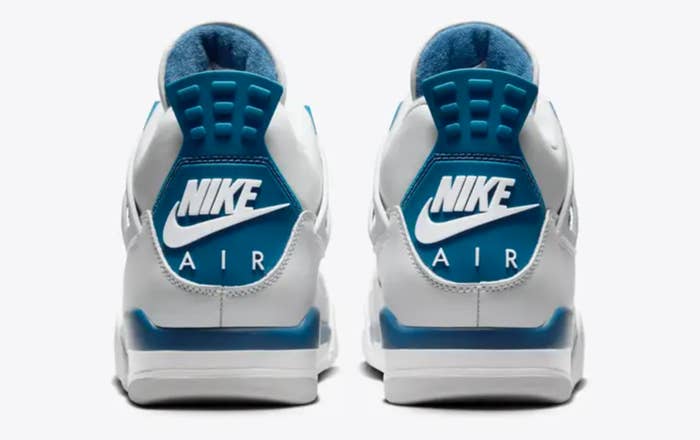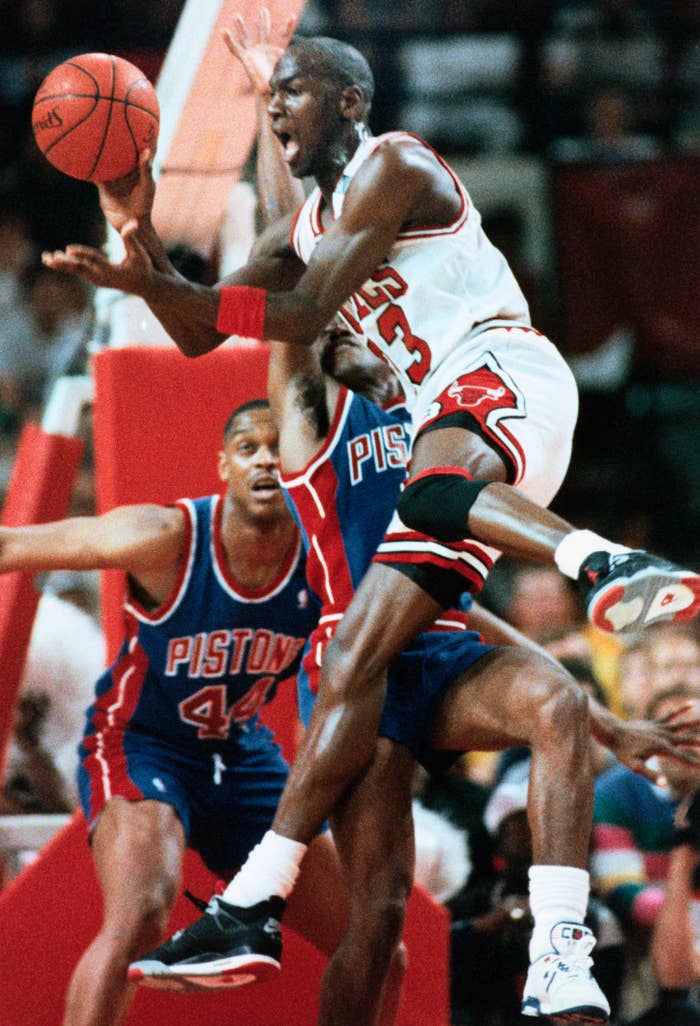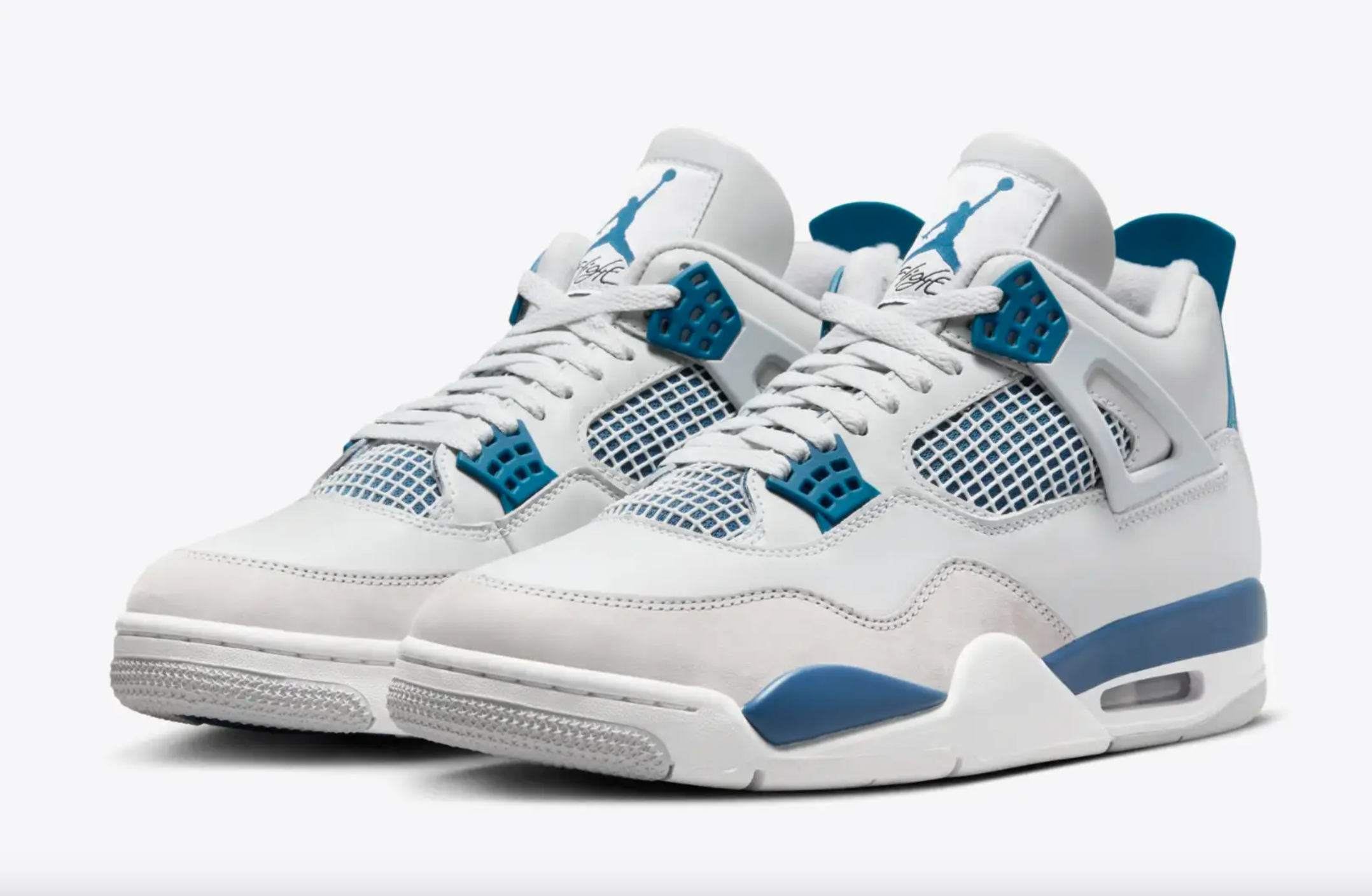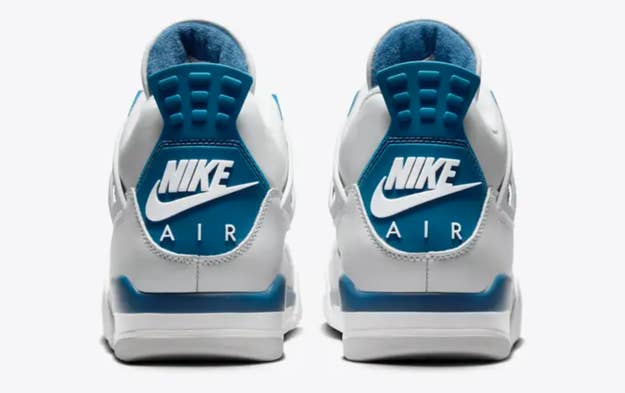
Jordan Brand’s betting that one of its biggest sneakers this year will be a retro of a shoe that’s traditionally been an alright sneaker for the brand. The Air Jordan 4 is right now a darling of Jordan Brand. Having burned through the Air Jordan 1, the 4 has taken the place as the brand’s flavor of the moment. And this year is seeing the “Military Blue” Air Jordan 4 return in its true original form for the first ever, with everything except its name.
The Air Jordan 4 first released in 1989. It was fresh off the heels of the Air Jordan 3, which saw Michael Jordan’s signature line get reinvented. The Air Jordan 1 was a revolutionary sneaker, but the line took a dip with the Air Jordan 2. Then, Jordan almost left Nike, the Air Jordan 3 saved the day, and the Air Jordan 4 built on the legacy created by its predecessor.
Spike Lee, playing his Mars Blackmon character, appeared in commercials with Jordan to promote the Air Jordan 3, and he returned to push the 4, too. But he played a bigger role in not only the anticipation of the Air Jordan 4, but also its cultural legacy when the character Buggin’ Out wore them in his film Do the Right Thing, only to have them run over by a white Larry Bird fan with his bicycle tire.

Backstory of the 4 aside, the “Military Blue” Air Jordan 4 is one of four colorways that were released in the sneaker’s initial run. It’s also the one version not to match Jordan’s Chicago Bulls colors, or at least be compatible with them. I think it’s unanimously agreed upon that the “Black Cement” 4 is the best, followed by “White Cement,” “Fire Red,” and then “Military Blue.”
That doesn’t make “Military Blue” bad by any means. The three other mentioned sneakers are certified classics. The “Black Cement” Air Jordan 4 is considered by many to be the greatest Jordan of all time. And the “White Cement” and “Fire Red” 4s have such strong connections to Jordan wearing them on court. But Jordan never wore the “Military Blue 4s” on the court. The sneakers didn’t cooperate with the NBA’s uniform guidelines at the time, and he didn’t break them out for the All-Star Game (he wore Black Cements) like he would with shoes like the Aqua 8s.
Jordan Brand has gone out of its way to make the other colorways feel special. It brought back the “Black Cement” and “White Cement” Air Jordan 4s in 1999 when it retroed the model for the first time. There was a white and blue 4 that was released that year, too, but it was the “Columbia” pair, which is substantially different from the Military Blues.
The “Military Blue” 4 wouldn’t see its first retro release until 2006. That era was much different than sneaker culture is now. This was the peak of forums like NikeTalk. There was a fervent audience for sneakers that had a connection to a bygone era. Many were collectors who were nostalgic for the sneakers and remembered them from the late ‘80s and early ‘90s. There was also a new crop of sneakerheads that were bit by the bug through the sneaker and streetwear renaissance of the 2000s, which saw retro sneakers, all-over-print hoodies, and vintage sportswear become the craze.

This confluence of generations served as the perfect storm for the “Military Blue” to have an impact upon its re-release. The old heads wanted it because they either had it back in the day and wanted a new pair, or they were chasing down the sneaker they never got to own. The younger generation wanted the shoes because the seniors in the scene let them know it was important through conversations they had on the forums. And no one called it gatekeeping back then. Funny, huh?
I remember seeing the shoes everywhere online. It felt like a big release, although people say they saw the sneakers eventually go on sale in some cities. There also wasn’t a huge resale culture, where people would buy up large quantities of the sneakers in hopes of flipping them online, back then. The most you would see is someone get two or three pairs and maybe unload one of them.
Common sense would indicate that if it took 27 years for a sneaker to be re-released for the first time, then it would take quite some time for it to see the day of light again. That wasn’t the case.
Six years later, sneaker collecting hit a new level. Nike Basketball got hot. LeBron, Kobe, and KD all had a run of signature shoes that turned the average hooper into a collector and permeated high school hallways and the closets of sneaker hoarders.
Jordan Brand was white hot as well. The brand’s focus on the Air Jordan 11 became the biggest thing that the retro sneaker industry had ever seen. Nike was able to sell hundreds of thousands of 11s every holiday season without fail (and still does to this day, and in even higher volumes). This turned casuals, or just people who wanted in on the buzz, into sneakerheads. Nearly every retro Air Jordan from 2010 to 2012 would sell out. Stuff that, if it were to release these days, would sit on shelves and go on sale: “Wolf Grey” 5s, “Cardinal” 7s, “Photo Blue” 9s. Pure outlet fodder in 2024. But they were hot in the 2010s. People were camping out for these sneakers.
So when the “Military Blues” re-released in 2012, you’d expect them to sell out. But that didn’t happen. It’s not that the sneakers suddenly became unpopular, but something else released that day that eclipsed the fourth-best original Air Jordan 4: the Nike Air Yeezy 2.

The sneakers both released on June 9, 2012. Except the Yeezys were made in the thousands and the Military Blues were likely made in 100 times the quantity. But it didn’t matter. People wanted the Yeezys. They were the hottest shoe going at that point, maybe save for the “Galaxy” Foamposites. The problem was that the majority of people couldn’t get them. But in that era, there was no StockX or reselling apps, and the general public was pretty uneducated about how to get a limited-edition shoe.
This moment might have just seemed like a blip on the radar, a mere coincidence. But it fits a narrative that Kanye West pushed shortly after the release of the Yeezy 2s on his 2012 track “New God Flow” from Cruel Summer, when West rapped, “I ain’t trying to stunt, man, but these Yeezys jumped over the Jumpman.”
There may have been more factors at play that caused the “Military Blues” to not instantly sell out in 2012, but it certainly was odd at the time.
We’re now 12 years past that release (just typing that out made me feel old). And the "Military Blue" 4s are set to retro for a third time. And they’re back in their original form. For the first time since their 1989 release, they have Nike Air on the heel tab.
Retro sneakers have changed a lot since 2006 and 2012. Back then, it was much more about just making sure the sneakers looked good enough. Not really a one-to-one bring back of an old shoe, but an artist’s rendering of the original model. But in this era, people expect retros to be as close to the original source material as possible. And it looks like the Military Blues this go around will do just that. Except for one thing. Jordan Brand’s not calling them “Military Blue.” They’ve been officially named the “Industrial Blue” Air Jordan 4.
There’s been quite a few conspiracy theories floating around as to why there was a change. On the surface, it would appear that Nike’s Portland crew is progressive to the point where they feel it’s inappropriate to use the word military at all (and I personally feel like there’s truth in that, but that’s just my opinion). The box itself says “Military Blue,” but they’re being called “Industrial Blue” through official Nike communications.
There’s been chatter online suggesting that the sneaker being white and blue and using the word “military” in the name would conjure connection to Israel’s military offensive against Palestine and destruction of Gaza. While this sneaker has zero to do with that and feels like a stretch in every way imaginable, I can imagine a mindset where Nike’s Portland employees wouldn’t want to tread into those waters.

But also, let the record show that Michael Jordan’s father served in the military; they’ve done “Armed Forces” Air Jordan 1s in the past, done a pair of friends and family Air Jordan 4s inspired by Aleali May’s father serving in the military, produced boots that are essentially only worn by active duty military folks, and had then-Commander-in-Chief Barack Obama speak on Nike’s campus. So to say that Nike is just a footwear brand and has zero historical connection to the military is bogus.
On the flipside, some people are saying, “As long as I can get the sneaker and they look right, I don’t care what they’re called.” And I totally understand that logic.
The sneakers don’t have the name written on them, and there’s nothing about the shoes that makes them more “Industrial Blue” than “Military Blue.” (Although, the color on this year’s version is a closer match to the original, and further from the last two retros.) And sneakers are meant to be worn, so you’re still getting what you paid for, for the most part. But, as a certified sneaker dork, I can see why the die-hard collectors are upset that an OG-esque sneaker has a different name. Some people get OCD about the sneakers they collect, and changing the name is enough to just bug them.
With all of that said, I don’t think the name being changed is going to stop the “Industrial Blue” 4 from being a big sneaker—they will probably even be on some Sneaker of the Year lists. They’ll probably sell out. Can’t imagine they’re going to resell for a ton. But who knows. I wish they had just left the sneaker with its original name. If it’s not broke, well, you know the rest.

